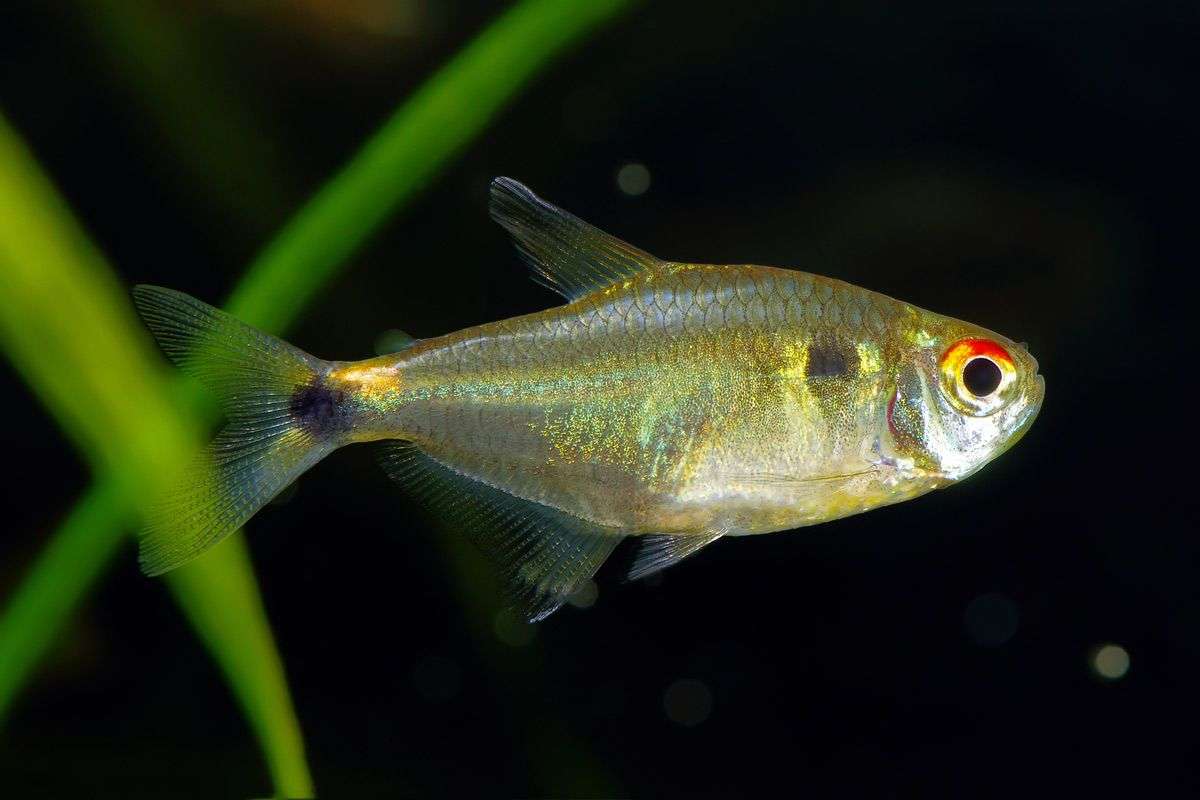How Big Do Fathead Minnows Get

Introduction
How Big Do Fathead Minnows Get: Fathead minnows, scientifically known as Pimephales promelas, are tiny but significant fish in the world of freshwater ecosystems. Their size, while modest, plays a crucial role in the intricate web of life that characterizes aquatic environments. These fish typically reach a size range of approximately 2 to 3 inches (5-7.5 cm) in length when fully grown, and they are known for their slender, streamlined bodies.
Despite their diminutive size, fathead minnows serve as essential components of food chains within ponds, lakes, and streams. Their small stature makes them vulnerable to predation, and they often fall prey to larger fish, waterbirds, and aquatic insects. However, their rapid reproduction and prolific nature compensate for the high predation rates, ensuring their presence in these ecosystems.
Biologists, ecologists, fishery managers, bait producers, and aquarium keepers all want to know fathead minnow sizes. Small but important, they contribute to nutrient cycle, energy transmission, and aquatic ecosystem balance, demonstrating that even the smallest residents are significant to freshwater ecosystems.

Will fathead minnows reproduce in a pond?
Fathead minnows swim slowly, which makes them easy to catch by larger fish. They also spawn frequently. When added to a pond they will create nests on the bottom which are about the size of a teacup. They like placing their eggs beneath plants, logs or rocks.
Yes, fathead minnows are known for their prolific reproductive habits and can reproduce in pond environments. These small freshwater fish are often chosen as bait fish for anglers due to their rapid reproduction rates. In a pond setting, fathead minnows can thrive and establish breeding populations if the conditions are suitable.
Reproduction typically occurs during the warmer months when water temperatures are conducive to breeding. The male fathead minnows construct small nest depressions in the substrate, often near submerged vegetation. They court females by displaying colorful breeding colors and engaging in courtship behaviors. Once the female deposits her eggs in the nest, the male fertilizes them and guards the nest until the eggs hatch.
In ponds with appropriate habitat features and favorable water conditions, fathead minnows can establish self-sustaining populations. However, it’s essential to note that their rapid reproduction can lead to overpopulation in small ponds, potentially impacting water quality and the overall balance of the ecosystem. As such, fathead minnow populations may need monitoring and management in pond environments to prevent overcrowding.
How fast does a fathead minnow grow?
Juveniles display rapid growth, reaching 45–50 mm total length in 90 days, and most fathead minnows die after spawning by the age of one year.
The growth rate of fathead minnows can vary depending on factors such as water temperature, food availability, and the specific conditions of their habitat. On average, under favorable conditions, fathead minnows tend to grow relatively quickly. They are known for their ability to reach maturity at a young age, often within their first year of life.
In the ideal temperature range of around 70-75°F (21-24°C), fathead minnows tend to exhibit the fastest growth rates. In these conditions, they can reach sizes of about 2-3 inches (5-7.5 cm) in their first year. However, it’s important to note that growth rates can slow down in colder water or when food resources are limited. Conversely, if food is abundant and conditions are optimal, fathead minnows may grow even faster, surpassing their average size range.
The adaptability and fast growth of fathead minnows make them a popular choice for bait and forage fish in various aquatic environments. Their rapid maturation and breeding cycles contribute to their reputation as a hardy and resilient species in both natural and controlled settings.
What is the maximum size of a fathead minnow?
Description. Adult Fathead Minnows are small in size, ranging from 1.6 to 4 inches (43 to 102 millimeters) in length – average length is 1.9 inches (50 millimeters). They have a rounded snout and short, rounded fins.
The maximum size of a fathead minnow (Pimephales promelas) typically ranges between 2 to 3 inches (5-7.5 cm) in length. These small, slender freshwater fish are known for their diminutive size and relatively short stature. Males and females may exhibit slight variations in size, but in general, they fall within this size range.
In rare cases, fathead minnows can grow slightly larger, but it’s uncommon for them to exceed 3 inches. Various factors can influence their size, including genetics, habitat conditions, and available food resources. Warmer water temperatures, abundant food supplies, and optimal environmental conditions can contribute to relatively larger individuals.
Despite their small size, fathead minnows play important ecological roles in aquatic ecosystems as prey for larger fish and waterbirds and as forage species in food chains. Their adaptability and rapid reproduction make them valuable components of various ecosystems and popular choices for bait and forage fish in aquaculture and fisheries management.
How much space do fathead minnows need?
Your pond should have at least 29 inches of depth, some planting, and some open space. All other pond fish can be raised with a Fathead minnow. A 4-inch shallow area with multiple oxygen-producing plants is ideal for propagation.
The amount of fathead minnows you keep, their function, and their behavior determine how much space they need. Small groups of fathead minnows can be kept in a 10-20 gallon aquarium. This accommodates swimming, foraging, filtration, and maintenance.
If you want to keep a larger population, especially for breeding or forage in a pond or tank, you need additional space. To allow fish to form territories, build nests, and reproduce naturally, breeding colonies should be in tanks of 50–100 gallons or more.
The size and purpose of an outdoor pond determine fathead minnow area needs. For a self-sustaining population, the pond must be large and deep enough to maintain water quality and provide breeding, feeding, and shelter. Consider your goals and the size of your minnow population when choosing a pond or tank for fathead minnows.
What is the lifespan of a fathead minnow?
Approximately three summers
Mortality of fathead minnows is high and the maximum life span for the species is approximately three summers.
Fathead minnows confront many obstacles in the wild that can shorten their longevity. They face predators including larger fish and waterbirds, and water quality, food, and habitat can affect their survival. Fathead minnows live in varied aquatic habitats in North America, hence their life expectancy might vary by region.
Fathead minnows flourish in captivity given good water, food, and protection from predators. They make good food fish, bait, and scientific research creatures in aquaria and outdoor ponds due to their prolific reproduction and short lifetime.
What is the typical size range for adult fathead minnows?
Adult fathead minnows (Pimephales promelas) are one of the tiniest freshwater fish species. Adult fathead minnows are 2–3 inches (5–7.5 cm) long. The species is distinguished from larger North American freshwater fish by its tiny size.
There is little length difference between male and female fathead minnows. Adult fathead minnows should be 2-3 inches long, however genetics, habitat, and food availability might affect growth. These modest size suits their biological responsibilities as prey for larger fish and waterbirds and vital parts of aquatic food chains and ecosystems.
Their flexibility and importance as forage fish in fisheries management and bait in angling are due to their small size. Fathead minnows are important in aquatic habitats and prolific reproducers despite their modest size.
Are there variations in the size of fathead minnows based on factors like habitat and diet?
Yes, variations in the size of fathead minnows can be influenced by several factors, including their habitat and diet. Habitat conditions play a crucial role in determining the size of these small freshwater fish. Fathead minnows residing in more favorable environments with ample food resources and suitable water quality may exhibit larger average sizes compared to those living in less hospitable or crowded habitats. In ponds or lakes with abundant food sources and limited competition, they may grow slightly larger.
Diet also plays a significant role in the size of fathead minnows. In environments where these fish have access to nutrient-rich food, they are more likely to attain larger sizes. A varied and plentiful diet contributes to their growth and size. Factors such as the availability of aquatic invertebrates, zooplankton, and other protein-rich foods can influence the overall health and size of fathead minnow populations.
Genetics can also play a part in size variability among fathead minnows. Different populations may exhibit slight variations in growth potential based on their genetic makeup. However, the impact of genetics on size is generally overshadowed by habitat and dietary factors. Overall, fathead minnows can adapt to their surroundings, and their size can be a reflection of the conditions in their specific habitat and their access to adequate nutrition.
How can the size of fathead minnows impact their role in aquatic ecosystems?
The size of fathead minnows can significantly impact their roles within aquatic ecosystems. Being a relatively small species of freshwater fish, their size influences their position in the aquatic food web and their interactions with both predators and prey.
- Prey Species: Fathead minnows’ small size places them in the category of prey species in many aquatic ecosystems. They are a common food source for a variety of larger fish, birds, and even some aquatic insects. Their rapid reproductive rates compensate for predation, as they can produce numerous offspring, ensuring their continued presence in the ecosystem.
- Forage Fish: Fathead minnows play a crucial role as forage fish, meaning they are an essential part of the diet of larger predatory fish. Their abundance and small size make them an ideal food source for game fish, including bass and pike. This role in transferring energy from smaller organisms to larger predators is vital in maintaining the overall balance of aquatic ecosystems.
- Nutrient Cycling: Despite their small size, fathead minnows contribute to nutrient cycling in aquatic systems. They feed on zooplankton and small invertebrates, recycling nutrients and energy within the ecosystem. Their role in nutrient cycling helps maintain water quality and overall ecosystem health.
The size of fathead minnows influences their role as both prey and forage species in aquatic ecosystems. Their position in the food web contributes to nutrient cycling, maintaining ecological balance, and serving as an indicator of environmental conditions, making them essential players in the complex interactions that define aquatic ecosystems.

Conclusion
The size of fathead minnows, typically ranging from 2 to 3 inches (5-7.5 cm) when fully grown, may be modest in the world of fish, but their significance in freshwater ecosystems is far from small. These unassuming fish, known for their streamlined bodies and diminutive stature, are integral players in the complex food webs of ponds, lakes, rivers, and streams across North America.
Their small size belies their ecological importance, as they serve as prey for a variety of larger fish, waterbirds, and aquatic insects, contributing to the transfer of energy in these ecosystems. Their rapid reproduction compensates for the high predation rates, ensuring their enduring presence.
Understanding the typical size of fathead minnows is not only relevant to anglers and bait producers but also to ecologists and conservationists. These fish play vital roles in nutrient cycling and the overall balance of aquatic environments, highlighting the interconnectedness of all species, regardless of their size. Their size may be small, but their impact on the health and vitality of freshwater ecosystems is undeniably significant, emphasizing the delicate yet robust tapestry of life that characterizes these habitats. Whether they swim in an aquarium or thrive in the wild, fathead minnows exemplify the principle that every member of an ecosystem, no matter its size, contributes to the intricate web of life.



